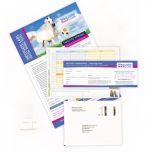The EquiSal Tapeworm Test (patent granted) is a simple-to-use horse saliva test for detecting harmful tapeworm infections in horses.
It was developed by family business, Austin Davis Biologics Ltd, who now provide a testing service to diagnose tapeworm burdens and recommend treatment. The EquiSal Tapeworm Test works like a blood test but, instead, uses saliva that horse owners are able to collect themselves using a specially designed saliva collection swab. The saliva swab is posted back to the laboratory in a preservative solution which keeps the sample stable for at least three weeks.
For more information on when to worm your horse, please read our Confused About Worming? article, written by our in-house SQP.
When ordering several EquiSal Saliva Tapeworm Tests, please ensure that all tests are carried out and sent back to EquiSal's lab at the same time to ensure that results are given in a timely manner.
- Buy 2 for £19.69 each and save 1%
- Buy 4 for £19.30 each and save 3%
- Buy 6 for £18.90 each and save 5%
- Buy 10 for £18.71 each and save 6%
Why Should I Test For Tapeworm?
Three species of tapeworm are capable of infecting horses; Anoplocephala perfoliata, Anoplocephala magna and Anoplocephaloides mamillana (previously known as Paranoplocephala mamilliana).
Of these, A. perfoliata is the most common in the UK. This tapeworm has a flattened body (strobila) and can grow up to 8 cm long by 1.5 cm wide. The body is made up of numerous segments (proglottids) and the head (scolex) has four suckers which the tapeworm uses to attach itself to the gut wall. It can be distinguished from the other species by the presence of flaps (lappets) on the head.
A. magna and A. mamillana are generally found in the small intestine, whereas A. perfoliata are usually found around the ileocaecal junction, between the small intestine and large intestine where the caecum is connected. Colonisation of the ileocaecal junction by A. perfoliata can result in physical damage to the tissue and the presence of large numbers can result in clinical disease such as colic.
Detection of Tapeworm
Tapeworm infections cannot be reliably detected using standard faecal egg counts. This is because of the way in which tapeworm eggs are released. Adult tapeworms shed mature segments full of eggs (gravid proglottids) into the faeces, and these segments rupture and release the eggs during passage through the intestine or within the environment. However, the low concentration and uneven distribution of eggs in the faeces combined with their sporadic release means that faecal egg counts usually substantially underestimate the true level of tapeworm infection or even misdiagnose infections completely. Although tapeworm eggs can be identified in faecal egg counts, distinguished by their characteristic shape, it is especially difficult to accurately diagnose moderate burdens of less than 20 tapeworms.
The EquiSal Tapeworm Test recognises tapeworm burdens, not by counting eggs, but by measuring antibodies present in the horse’s saliva. When a tapeworm infection is detected by the immune system, tapeworm-specific antibodies are produced. It is these antibodies that the EquiSal Tapeworm Test uses to diagnose tapeworm burdens. The EquiSal Tapeworm Test distinguishes between low, borderline or moderate/high tapeworm burdens.
Blood tests are also capable of accurately diagnosing burdens in horses and they are also based on the level of tapeworm-specific antibodies present.
How Do I Test For Tapeworm?
The EquiSal Tapeworm Test (patent granted) is a simple-to-use horse saliva test for detecting harmful tapeworm infections in horses. It was developed by family business, Austin Davis Biologics Ltd, who now provide a testing service to diagnose tapeworm burdens and recommend treatment. The EquiSal Tapeworm Test works like a blood test but, instead, uses saliva that horse owners are able to collect themselves using a specially designed saliva collection swab. The saliva swab is posted back to the laboratory in a preservative solution which keeps the sample stable for at least three weeks.
During 2012 and 2013 the research team, consisting of three experienced scientists (one of whom was an inventor of the Clear Blue pregnancy test), developed and rigorously validated this innovative test before launching the diagnostic service during April 2014.
The test measures tapeworm-specific antibodies in saliva, using a combination of three laboratory tests (called ELISAs*). Each sample is analysed under very carefully defined conditions to account for variations in saliva flow and impact of diet. The saliva samples are handled by an automated liquid handing system to ensure very high accuracy, as well as high-fidelity sample tracking throughout the test procedure. An algorithm is applied to integrate data from the three different tests to generate an EquiSal diagnosis of tapeworm burden – the saliva score.
The table below shows the results provided by the EquiSal Tapeworm test service. The test identifies horses with low burdens, borderline results or moderate/high burdens and treatment is recommended as detailed.

* An average moderate/high saliva score is approximately 16, but very high scores can reach into the hundreds. Regardless of the saliva score, any horse with a borderline or moderate/high result should be treated.
EquiSal Tapeworm Test accuracy
The EquiSal Tapeworm Test was validated by testing saliva samples taken from horses in which the number of tapeworms present had been counted at post-mortem. In scientific terms, the EquiSal Tapeworm Test has both high sensitivity and specificity, which is important for correctly identifying horses with tapeworm burdens.
The majority of horses with one or more tapeworms at post-mortem were correctly identified by the test. The remaining few were diagnosed as being negative but these horses had burdens considered by experts to be not pathogenic (pathogenic meaning capable of producing disease), amounting to no more than 20 tapeworms. This is similar to the current guidelines for redworm faecal egg counts (FEC), where a result of less than 200 eggs/gram is not recommended for treatment.
This means that the EquiSal Tapeworm Test can be relied upon to:
- Correctly identify the majority of horses with a moderate/high burden
- Correctly identify all horses with pathogenic burdens
When data from a tapeworm blood test and the EquiSal Tapeworm test were compared, they were shown to have strong positive correlation with each other. When these tests didn’t give the same diagnosis, it was when non-pathogenic burdens were present (less than 20 tapeworms). The tapeworm blood test and EquiSal Tapeworm test were found to have the same level of accuracy at diagnosing tapeworm burdens.
Please click here to download our scientific information leaflet.
Our validation paper has been published in Veterinary Clinical Pathology. To view this online, click here.
Publication in a peer reviewed journal means that subject specialists have fully reviewed, or refereed, the research paper. The publication of the EquiSal Tapeworm validation paper therefore demonstrates quality of science, reliability of the findings and that the research is of an accepted standard. The paper details the methods we use for the EquiSal test and the full validation of the test against the blood test as well as post mortem samples when tapeworms were counted.
Independent validation
The veterinary consultant at Bransby Horses Charity carried out a small independent comparison of EquiSal Tapeworm testing versus the current blood test which showed strong positive correlation of the test results. The Bransby Horses team has since started using EquiSal regularly and endorse the test. “Having conducted a trial comparing EquiSal with blood testing in 2014 and obtained extremely comparable results, Bransby Horses decided to conduct all of its subsequent routine tapeworm testing with the EquiSal Tapeworm assay, as many of our horses, ponies and donkeys tolerate the technique far better than blood testing. EquiSal has become integral to our targeted tapeworm control programme and thereby contributed to the very significant decline in tapeworm infestation that we have managed to achieve in recent years.” Jeremy Kemp-Symonds, veterinary consultant.
A day in the life of an EquiSal Tapeworm test
When saliva samples arrive at the lab, the unique barcode label on each sample is scanned into the database along with the horse’s name. This information allows us to track samples throughout the testing process, as well as telling us information about the sample, such as where the kit was purchased and where the results need to be sent back to. We then remove and discard the swabs from the tubes – the remaining samples range in colour enormously, from colourless to dark green or brown, and sometimes there are particles of grass or food present.
The samples are loaded onto the automated robotic liquid handling system to carry out dilutions, additions and to pipette each sample into pre-prepared ELISA* test plates. Each sample is tested twice in three different ELISA tests to give the final result. This meticulous procedure ensures the test has high accuracy and that saliva flow rate and other saliva variables do not affect the results.
The test plates are incubated with a series of different solutions, one of which results in the development of a blue colour. The test is stopped with a final solution resulting in a colour change from blue to yellow and the intensity of the yellow colour is measured. The result, which is linked to the barcode for each sample, is collected and processed.
The results are quality checked and verified by two experienced scientists before being emailed out to vets, SQPs and horse owners.
*ELISAs (Enzyme Linked ImmunoSorbant Assays) are common diagnostic tests used in medicine, veterinary medicine and various industries.
EquiSal kits are only available for purchase by customers in the United Kingdom.| Brand | EquiSal |
|---|---|
| Presentation | Kit |
| Applicator/ Dispenser | No Applicator included |
| Size | Kit |
| My Product Must Be... | Safe for Lactation, Safe for Pregnancy |
| Warnings | Make sure that your horse has not exercised or eaten for at least 30 minutes before conducting the test. |
| Instructions for use | Important: Your horse must not have eaten or been exercised for 30 minutes before testing. All you have to do is to use the specially designed swab to collect a saliva sample from your horse by inserting it in the side of his mouth in the space where the bit normally sits. Wait for the indicator to turn pink. This shows that enough saliva has been absorbed into the swab and can take a few minutes. Pop the swab into the collection tube, and return it to the Austin Davis Biologics laboratory in the pre-paid postage bag. We will then contact you with the results of the test. |
| Unsure about worming? | If you have any questions about worming your horse please do not hesitate to contact Hannah, our SQP, on 01995 671787 or email hannah@supplementsolutions.co.uk. |


![EquiSal Saliva Tapeworm Test [Worm Count Kit] (Equine) EquiSal Saliva Tapeworm Test [Worm Count Kit] (Equine)](https://media.supplementsolutions.co.uk/media/amasty/amlabel/bulkbuynew.png)








